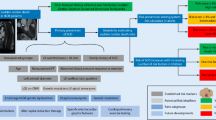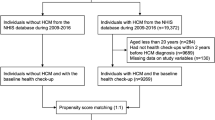Abstract
Hypertrophic cardiomyopathy (HCM) is associated with adverse outcomes, such as heart failure, arrhythmia, and mortality. Sudden cardiac death (SCD) is a common cause of death in HCM patients, and identification of patients at a high risk of SCD is crucial in clinical practice. The China Hypertrophic Cardiomyopathy Project is a hospital-based, multicenter, prospective, registry cohort study of HCM patients, covering a total of 3000 participants and with a 5-year follow-up plan. A large number of demographic characteristics and clinical data will be fully collected to identify prognostic factors in Chinese HCM patients. Furthermore, the main purpose of this study is to integrate demographic and clinical characteristics to establish new 5-year SCD risk predictive equations for Chinese HCM patients by the use of machine learning technologies. The project has crucial clinical significance for risk stratification and determination of HCM patients with high risk of adverse outcomes.
Clinical trials registration
ChiCTR2300070909
Similar content being viewed by others
References
Tuohy CV, et al. Hypertrophic cardiomyopathy: the future of treatment. Eur J Heart Fail. 2020;22(2):228–40.
Ommen SR, et al. 2020 AHA/ACC guideline for the diagnosis and treatment of patients with hypertrophic cardiomyopathy: a report of the American College of Cardiology/American Heart Association Joint Committee on Clinical Practice Guidelines. Circulation. 2020;142(25):e558–631.
Liu J, et al. Improvement in sudden cardiac death risk prediction by the enhanced American College of Cardiology/American Heart Association strategy in Chinese patients with hypertrophic cardiomyopathy. Heart Rhythm. 2020;17(10):1658–63.
Semsarian C, et al. New perspectives on the prevalence of hypertrophic cardiomyopathy. J Am Coll Cardiol. 2015;65(12):1249–54.
Norrish G, et al. Clinical features and natural history of preadolescent nonsyndromic hypertrophic cardiomyopathy. J Am Coll Cardiol. 2022;79(20):1986–97.
Maron BJ. Clinical Course and Management of Hypertrophic Cardiomyopathy. N Engl J Med. 2018;379(7):655–68.
Authors/Task Force, m., et al., 2014 ESC guidelines on diagnosis and management of hypertrophic cardiomyopathy: the Task Force for the Diagnosis and Management of Hypertrophic Cardiomyopathy of the European Society of Cardiology (ESC). Eur Heart J, 2014. 35(39): p. 2733-79.
Maron MS, et al. Enhanced American College of Cardiology/American Heart Association strategy for prevention of sudden cardiac death in high-risk patients with hypertrophic cardiomyopathy. JAMA Cardiol. 2019;4(7):644–57.
Dong Y, et al. Validation of the 2020 AHA/ACC risk stratification for sudden cardiac death in Chinese patients with hypertrophic cardiomyopathy. Front Cardiovasc Med. 2021;8: 691653.
Wang, J., et al., Assessment of late gadolinium enhancement in hypertrophic cardiomyopathy improves risk stratification based on current guidelines. Eur Heart J, 2023.
Leonardi S, et al. Usefulness of cardiac magnetic resonance in assessing the risk of ventricular arrhythmias and sudden death in patients with hypertrophic cardiomyopathy. Eur Heart J. 2009;30(16):2003–10.
Hen Y, et al. High signal intensity on t2-weighted cardiovascular magnetic resonance imaging predicts life-threatening arrhythmic events in hypertrophic cardiomyopathy patients. Circ J. 2018;82(4):1062–9.
Ismail TF, et al. Role of late gadolinium enhancement cardiovascular magnetic resonance in the risk stratification of hypertrophic cardiomyopathy. Heart. 2014;100(23):1851–8.
Ochoa JP, et al. Formin Homology 2 domain containing 3 (FHOD3) is a genetic basis for hypertrophic cardiomyopathy. J Am Coll Cardiol. 2018;72(20):2457–67.
Lopes LR, et al. Alpha-protein kinase 3 (ALPK3) truncating variants are a cause of autosomal dominant hypertrophic cardiomyopathy. Eur Heart J. 2021;42(32):3063–73.
Matthia EL, et al. Circulating biomarkers in hypertrophic cardiomyopathy. J Am Heart Assoc. 2022;11(23):e027618.
Johnson KW, et al. Artificial intelligence in cardiology. J Am Coll Cardiol. 2018;71(23):2668–79.
Motwani M, et al. Machine learning for prediction of all-cause mortality in patients with suspected coronary artery disease: a 5-year multicentre prospective registry analysis. Eur Heart J. 2017;38(7):500–7.
Deo RC. Machine learning in medicine. Circulation. 2015;132(20):1920–30.
Weng SF, et al. Can machine-learning improve cardiovascular risk prediction using routine clinical data? PLoS One. 2017;12(4):e0174944.
Heo J, et al. Machine learning-based model for prediction of outcomes in acute stroke. Stroke. 2019;50(5):1263–5.
Alaa AM, et al. Cardiovascular disease risk prediction using automated machine learning: a prospective study of 423,604 UK Biobank participants. PLoS One. 2019;14(5):e0213653.
Al’Aref SJ, et al. Clinical applications of machine learning in cardiovascular disease and its relevance to cardiac imaging. Eur Heart J. 2019;40(24):1975–86.
Javaid A, et al. Medicine 2032: The future of cardiovascular disease prevention with machine learning and digital health technology. Am J Prev Cardiol. 2022;12:100379.
Lang RM, et al. Recommendations for cardiac chamber quantification by echocardiography in adults: an update from the American Society of Echocardiography and the European Association of Cardiovascular Imaging. J Am Soc Echocardiogr. 2015;28(1):1–39 (e14).
Sasson Z, et al. Doppler echocardiographic determination of the pressure gradient in hypertrophic cardiomyopathy. J Am Coll Cardiol. 1988;11(4):752–6.
Kumar S, et al. Standardized goal-directed valsalva maneuver for assessment of inducible left ventricular outflow tract obstruction in hypertrophic cardiomyopathy. J Am Soc Echocardiogr. 2018;31(7):791–8.
Veselka J, Anavekar NS, Charron P. Hypertrophic obstructive cardiomyopathy. Lancet. 2017;389(10075):1253–67.
Porter TR, et al. Guidelines for the cardiac sonographer in the performance of contrast echocardiography: a focused update from the American Society of Echocardiography. J Am Soc Echocardiogr. 2014;27(8):797–810.
Kramer CM, et al. Hypertrophic cardiomyopathy registry: the rationale and design of an international, observational study of hypertrophic cardiomyopathy. Am Heart J. 2015;170(2):223–30.
Ingles, J. and D.G. MacArthur, The moral and practical urgency of increasing diversity in genomics. Eur Heart J, 2023.
Ingles J, et al. Evaluating the clinical validity of hypertrophic cardiomyopathy genes. Circ Genom Precis Med. 2019;12(2):e002460.
Wang J, et al. Malignant effects of multiple rare variants in sarcomere genes on the prognosis of patients with hypertrophic cardiomyopathy. Eur J Heart Fail. 2014;16(9):950–7.
Pua CJ, et al. Genetic studies of hypertrophic cardiomyopathy in singaporeans identify variants in TNNI3 and TNNT2 that are common in chinese patients. Circ Genom Precis Med. 2020;13(5):424–34.
Walsh R, et al. Minor hypertrophic cardiomyopathy genes, major insights into the genetics of cardiomyopathies. Nat Rev Cardiol. 2022;19(3):151–67.
Funding
This study was supported by grants from the National Natural Science Foundation of China (82170331), Joint Funds from the National Natural Science Foundation of China (U21A20337), and grants from the Key Research and Development Plan of Zhejiang Province (2020C03017).
Author information
Authors and Affiliations
Contributions
X.G. was responsible for the concept and design of the study. Z.D. contributed to the drafting of the article. K.W., Y.C., X.X., R.Z., and F.D. reviewed and edited the draft. All authors read and approved the final manuscript.
Corresponding author
Ethics declarations
Ethics Approval and Consent to Participate
All procedures followed were in accordance with the ethical standards of the responsible committee on human experimentation (institutional and national) and with the Helsinki Declaration of 1975, as revised in 2000 (5). This protocol was approved by the Ethics Committee of The First Affiliated Hospital, Zhejiang University School of Medicine (No. IIT220434B-R2). Informed consent was obtained from all patients for being included in the study.
Competing interests
The authors declare no competing interests.
Patient and Public Involvement
Patients and/or the public were not involved in the design, or conduct, or reporting, or dissemination plans of this research.
Additional information
Associate Editor Paul J. R. Barton oversaw the review of this article.
Publisher's Note
Springer Nature remains neutral with regard to jurisdictional claims in published maps and institutional affiliations.
Supplementary Information
Below is the link to the electronic supplementary material.
Rights and permissions
Springer Nature or its licensor (e.g. a society or other partner) holds exclusive rights to this article under a publishing agreement with the author(s) or other rightsholder(s); author self-archiving of the accepted manuscript version of this article is solely governed by the terms of such publishing agreement and applicable law.
About this article
Cite this article
Du, Z., Wang, K., Cui, Y. et al. The China Hypertrophic Cardiomyopathy Project (CHCMP): The Rationale and Design of a Multicenter, Prospective, Registry Cohort Study. J. of Cardiovasc. Trans. Res. (2024). https://doi.org/10.1007/s12265-023-10477-4
Received:
Accepted:
Published:
DOI: https://doi.org/10.1007/s12265-023-10477-4




